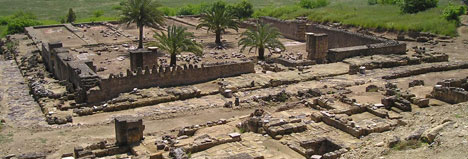Córdoba’s Medina Azahara holds many more secrets of the first Islamic rule of Spain
INHABITED for just a few decades and forgotten for an entire millennium, the intriguing history of Córdoba’s Medina Azahara will take many more years to fully reveal itself. The palace-city is now “the most important medieval archaeological site in the whole of Europe,” according to former government minister and archaeology expert, Manuel Pimentel.
And, as if to prove its worth, archaeologists at the Moorish site recently revealed an entire mosque dating from the tenth century. Measuring 25 metres in length, the building was constructed to face Mecca.
The excited team of archaeologists unveiled their discovery on November 16, pointing out the mosque’s alminar, the tower from which the faithful would have been called to prayer, as well as an outstanding mihrab – a polygonal niche which indicates the direction those praying should face.
The discovery is the most significant since excavations at the site restarted in earnest in April 2007. Yet it is thought that 90 per cent of the medina remains buried.

Built between 936 and 940AD by Abd ar-Rahman III (Adberramán III in Spanish), the first caliph of Córdoba and member of the Umayyad dynasty, the complex was modelled on the Grand Mosque of Damascus. Dating back to the seventh century, this is the oldest existing mosque in the world.
Medina Azahara was lauded in written documents of the time – both Muslim and Christian – for its unique and intriguing beauty.
Constructed on 112 hectares of land outside Córdoba, the city combined aesthetic charm with technical construction to present a formidable demonstration of the architecture of power.
The sentimental version of history tells us that al-Zahara was built for the caliph’s favourite concubine; but most believe it was simply constructed to be an imposing display of political might, as Abd ar-Rahman III built the city when his power was at a peak in the Islamic world.
Its grandiose design and technical genius make the complex a fitting capital city of Al-Andalus. But a devastating civil war in the 11th century succeeded in razing the entire city – destroyed by Berber soldiers less than a century into its life.
For most of the last millennium, Medina Azahara lay untouched, presumed to be Roman ruins and referred to as ‘old Córdoba.’
Modern excavations have barely scratched the surface, hence there is much more that is not known about the history of the palace and the culture of those it housed – secrets locked away beneath the earth.
Click here to read more News from The Olive Press.







Hello – congratulations – at last a decent English language local paper with a focus on the important issues – Merry X-mas to you all and keep up the excellent work.
ML Smets – Belgian national who lived and worked in Andalucia for he lat 21 years
That’s going to be another great tourist site for Spain
Not a lot to see at the moment, I was there last week. Also quite difficult for the visitor to interpret the site, especially if you don’t know much about it. There’s quite a good visitors centre but all the explanations are in Spanish! Not much use to the non-Spanish speakers.